Mountain pine Pumilio: description, planting and care
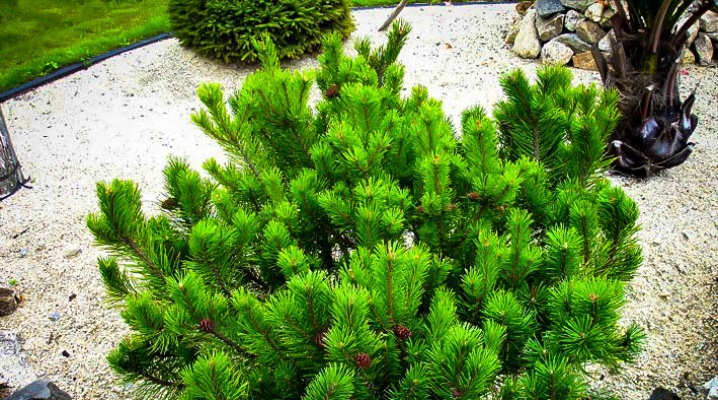
In the past few years, conifers have been very popular among landscape designers, which allow not only to decorate the territory, but also to improve the air quality, which is an important aspect for large cities and industrial zones. More and more often, green spruces, junipers and pines can be seen near administrative buildings, hospitals and highways. The long and painstaking work of breeders has made it possible to obtain a huge number of coniferous varieties and their subspecies, which differ in size, color and shape.
Experts, before starting to decorate the site, recommend paying attention to the Pine family, namely, one of its varieties - the mountain pine Pumilio.
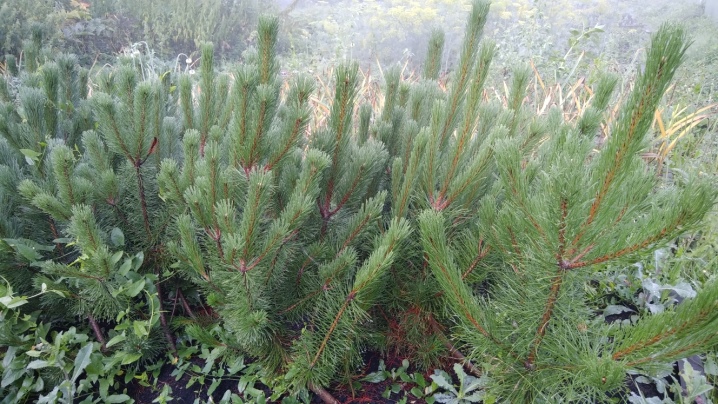
Description
Mountain pine (Pinus mugo) is a coniferous plant that belongs to the Pine family (Pinus) and has several varieties, one of which is Pumilio. Pumilio pine (Pinus mugo Pumilio) is a dwarf coniferous plant that grows in the mountains and looks like a bush. The homeland of this subspecies is the slopes of southern and eastern Europe. The crown shape spreads about 3 m in diameter. The maximum height of an adult plant is 150 cm. Life expectancy in favorable and comfortable conditions often reaches 200 years.


This subspecies has a low annual growth, which does not exceed 5 cm in 12 months. The height of a thirty-year-old tree often does not exceed 100 cm. The color of the needles is deep green, and the length can reach 5 cm. The fruits of Pumilio are cone-shaped cones about 4 cm long, which appear only 7 years after planting. The color of young cones ranges from blue to purple, and their ripening occurs in the fall of the year following pollination.
The bark of an adult plant is covered with cracks and dark spots. A distinctive feature of this subspecies is the presence of upward growing shoots, which subsequently, under the weight of their weight, are located horizontally to the ground. Thanks to the densely growing branches, the bush looks compact and collected. The plant has a powerful and branched root system, most of which is located on the surface.
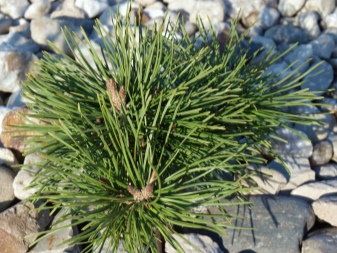

Due to its unpretentiousness, such a plant grows well both in parks and green recreation areas, and near highways and on flower beds near industrial facilities.
Differences from other varieties
The family of mountain pines is represented by several subspecies of conifers, each of which has its own distinctive features, as well as advantages and disadvantages. Experts recommend paying attention to the main advantages of this subspecies:
- the ability to grow in various climatic conditions;
- unpretentiousness;
- ease of care;
- wind resistance;
- resistance to low temperatures and drought;
- the possibility of growth in ecologically unfavorable regions;
- the presence of a well-developed root system;
- the ability to grow in pots and shape the crown.
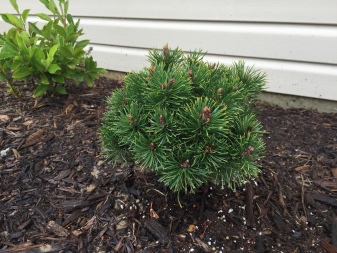
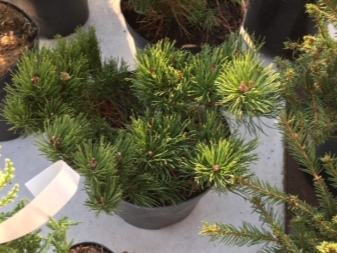
Pomilio is very often compared to the large Mugo Mugus, whose height can reach 3 m. Pumilio is a dwarf plant with a maximum height of no more than 1.5 m. This feature allows designers to use pine both for open ground and for planting in decorative pots.Gardeners cannot but rejoice at the absence of the need for watering adult shrubs.
However, the subspecies Mugus is necessary in the summer, be sure to water. Both plants belong to the natural form, which, unlike varietal plants, are rarely affected by pests and diseases. No less beautiful relatives of the mountain Pomilio, which have their own characteristics, are the conifers described below.
- Dwarf. A compact plant with a round crown and dark green needles, in which cones begin to form the next year after planting. For the first ten years, the plant grows very slowly in height, but starting from the 11th year of life, the growth rate increases significantly.
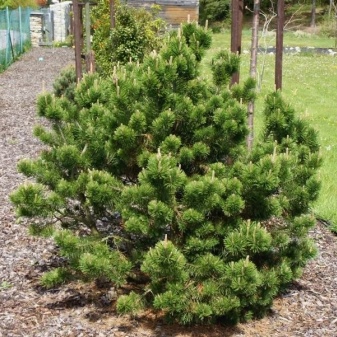
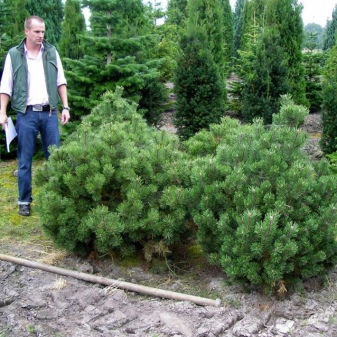
- Pug... A coniferous bush with a pillow-like shape. The plant has short green-blue needles.
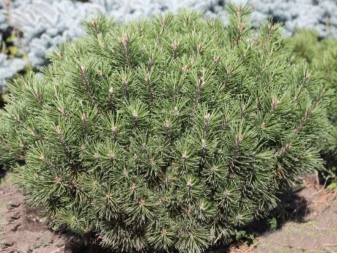

- Humpy. A new look that doesn't require a haircut. A distinctive feature is the autumn change in the shade of the needles from green to brown.
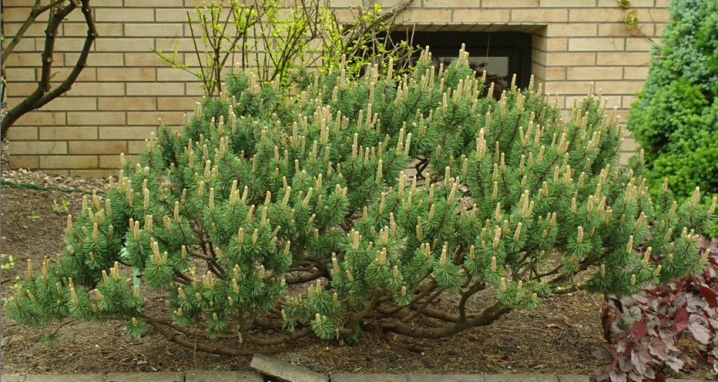
- Hedgehog. Slow growing species, which has an annual growth of no more than 2 cm.The height of the plant does not exceed 40 cm.
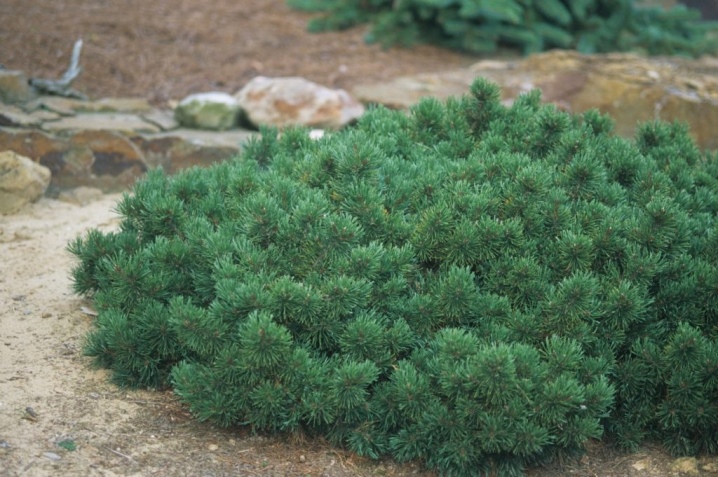
- Ophir Is a dwarf pine that is yellow in winter and autumn, and green in spring and summer. The shape of the bush is a flattened sphere. The crown diameter reaches 60 cm.

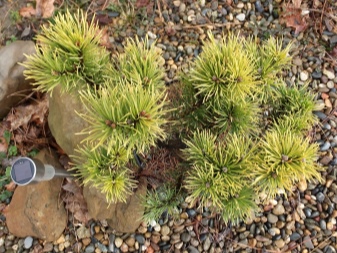
How to plant?
Pumilio is an unpretentious plant that can be planted in various climatic conditions. The coniferous shrub is quickly and easily accepted in both acidic and alkaline soils. Even the minimum content of nutrients in the soil is not an obstacle to growth. To get a beautiful plant with rich needles, experts recommend planting it in well-lit areas with a minimum amount of shadow.
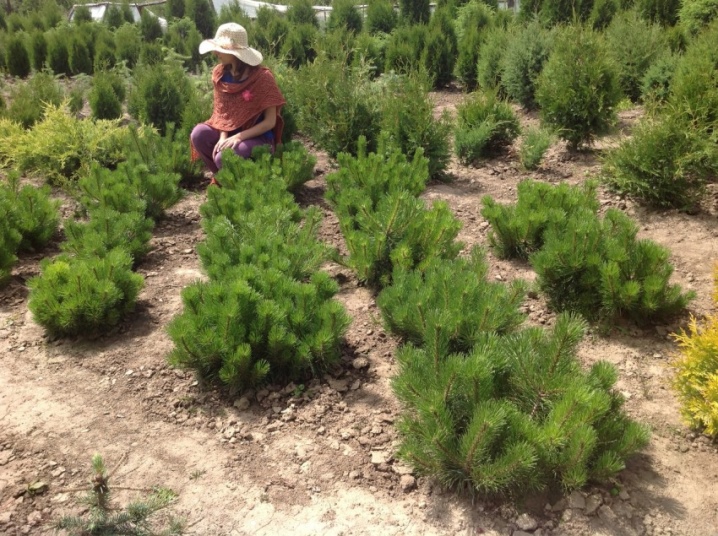
It is better to purchase planting material in large specialized nurseries that sell quality products adapted to a specific region. Shoots purchased from the markets may not correspond to the declared genetic characteristics. High-quality planting material should have the following characteristics:
- flexible branches and firmly seated needles;
- fresh scent of pine needles;
- no signs of illness;
- wet earthen lump;
- lack of dry needles with brown spots.

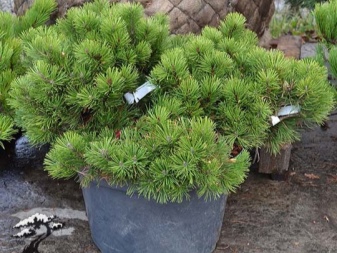
The optimal time for planting is early May and September. The seedlings should not be less than 3 years old, but not more than 5 years old.
Planting work should consist of the following stages:
- the formation of a planting pit, the size of which should be 2 times the diameter and height of the root system;
- arrangement of a drainage layer of medium gravel and sand;
- the formation of an earthen embankment in the center of the planting pit;
- placing a seedling in a pit with simultaneous compaction of the nutrient soil (the root collar should be located at a distance of 1 cm from the ground);
- mulching of the root zone with a peat substrate;
- abundant watering of the planting pit;
- fixing the young shoot to the established support.
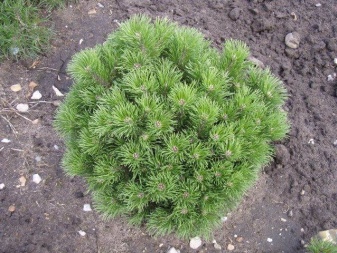
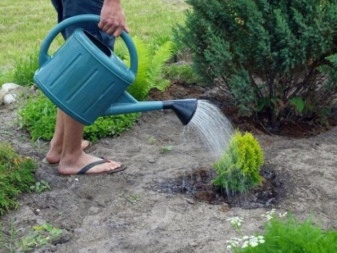

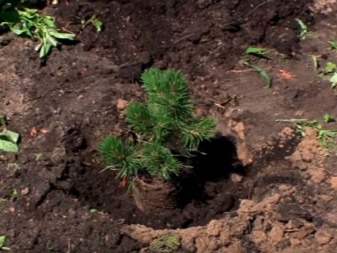
The optimal soil substrate is a mixture of turf, sand, clay and a small amount of lime, as well as leaf humus. It is strictly forbidden to use fresh chips and sawdust for mulching. If the seedlings need to be planted strictly along one line for landscaping the curb zones or the area near the fence, then it is better to replace the planting hole with a trench, in which planting material should be placed at a distance of 2 m from each other.
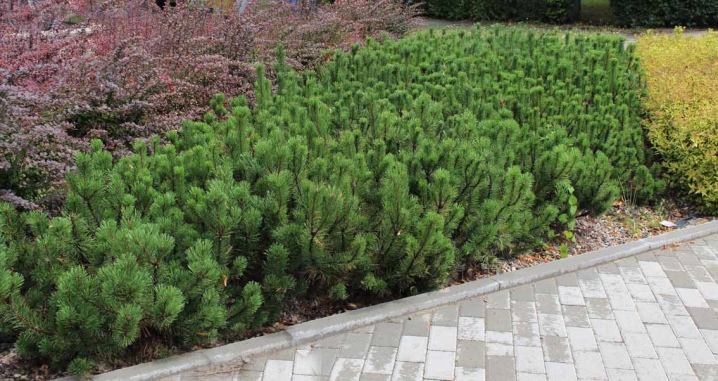
To prevent drying of young shoots planted in spring, and to protect them from the scorching sun, experts recommend creating special shading structures. Such designs will help plants take root faster and prevent rust.
How to care?
The process of caring for a pine tree will not cause difficulties even for novice summer residents and gardeners. In summer, young plants should be watered at least once every 2 weeks. Moistening the soil near old pines should be carried out only in urgent need during a period of prolonged drought and lack of rain. The optimal amount of water for one bush is 15 liters. To prevent the formation of an earthen crust, which prevents the penetration of oxygen into the root system, it is better to loosen the soil in the root zone the next day after watering.
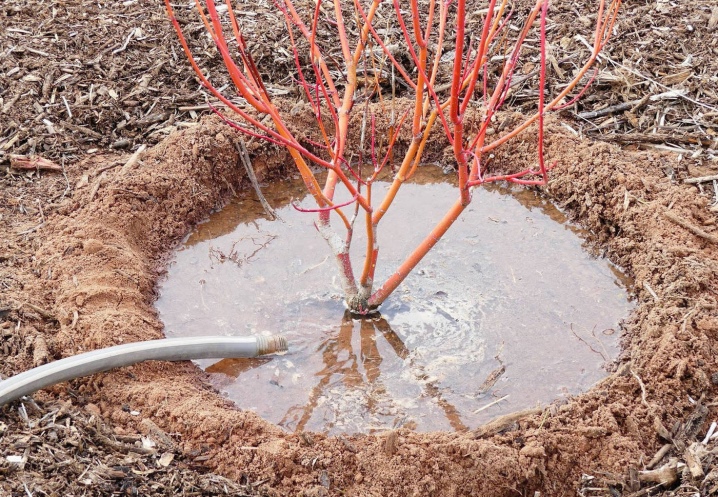
To provide the shrub with all the necessary nutrients, it is necessary Use special mineral fertilizers once a year. The needles respond positively to foliar feeding and organic matter. Pines that are more than 10 years old do not need fertilization at all. At the end of autumn, professional gardeners recommend tying all branches into one bundle, which will not allow the shoots to deform under the weight of snow and ice. A thick layer of mulch will prevent roots from freezing and retain spring moisture.

In the spring, after the stabilization of positive temperatures you need to remove all covering materials and cut off all dry and damaged branches... Watering with warm water will help the plant wake up faster after hibernation. To give the bush a beautiful appearance and the necessary shape, it is necessary to regularly carry out corrective pruning. It is necessary to carry out this procedure with a special tool and only in early spring.

Reproduction
You can get young plants on your own using the following propagation methods:
- seed;
- cuttings;
- grafting.
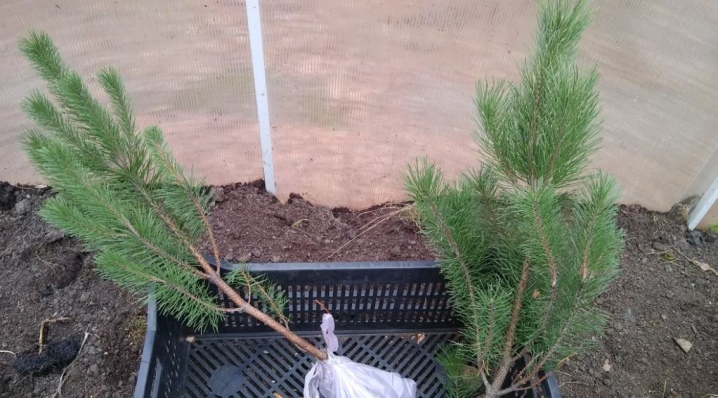
Seed propagation is a lengthy and not always successful method. Plants grown from seeds do not always inherit maternal genetic characteristics. Some gardeners choose a grafting method that also has a low level of effectiveness and is very difficult and time consuming for the novice gardener. Without practical and theoretical knowledge, it is better not to apply this method.
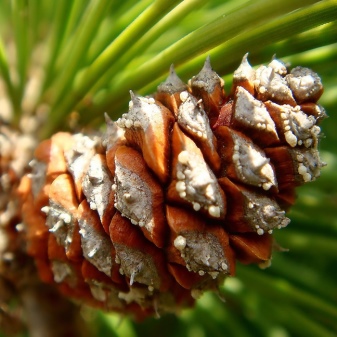
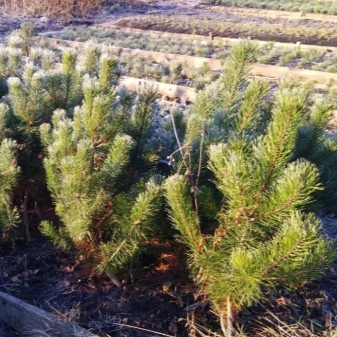
The easiest and fastest way to propagate pine is grafting. It is with the help of this method that new and healthy young shoots can be obtained quickly and without unnecessary material and physical costs. The main stages of grafting:
- harvesting planting material by breaking off the processes along with a part of the maternal cortex;
- placing the shoot in water for 2 hours;
- processing of sections with stimulants of the growth of the root system;
- planting shoots in prepared fertile soil;
- placing planting containers in a greenhouse or covering the site with plastic wrap;
- regular soil moistening.

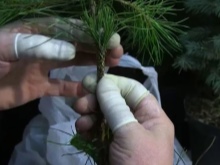
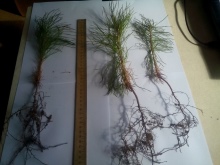
If the plant has begun and began to form new shoots, then in the fall it can be planted in a permanent place of growth.
Diseases and pests
Pumilio pine is a plant that is very rarely exposed to the destructive effects of viral and fungal diseases. The following dangerous pests can spoil the appearance of the bush and lead to its death:
- subcutaneous tick - a dangerous insect that leads to lightening of the needles and drying out of young shoots;
- shield - a parasite, after the appearance of which the needles acquire a brown hue and begin to crumble, and a sticky and sticky liquid appears on the entire surface of the bush.
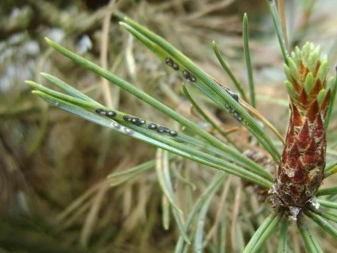
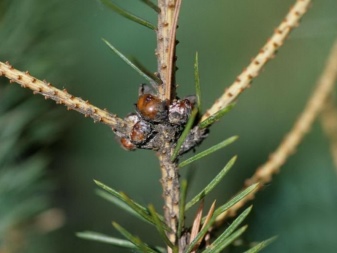
We shouldn't forget about pine hermes, mealybug and pine scoop. To prevent the appearance of dangerous pests, experts recommend regularly examining the plants and, if necessary, spray the bushes with special chemicals.
Application in landscape design
Pumilio pine is not only a beautiful plant that is widely used by landscape designers to decorate the territory, but also very useful. Due to the release of medicinal phytoncides, it disinfects the air and has a beneficial effect on the human respiratory system, therefore it is massively planted near hospitals, boarding houses and in industrial regions where the air contains a large amount of polluting and hazardous elements.
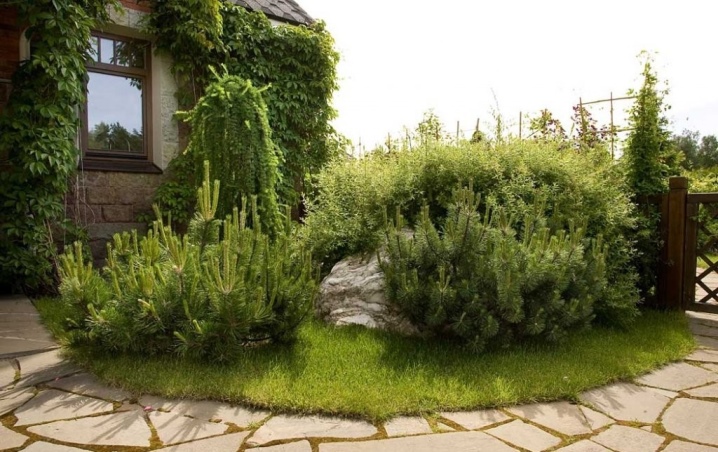
The dwarf size and low growth rate of the pine allows designers to plant it in special decorative containers that can become part of a huge number of beautiful design solutions. Coniferous flowerpots can decorate summer grounds, balconies, verandas, loggias and even roofs.
Pines look spectacular and beautiful on the banks of artificial reservoirs in combination with large boulders and decorative stones. The plant can be used as a dividing element near paths, entrances and fences. Pine trees can become part of Japanese gardens and rock gardens. Some gardeners create beautiful compositions of flowering plants and cereals near coniferous shrubs.
An amazing plant not only does not oppress green neighbors, but also creates a light shadow near them in the hot season. If you correctly distribute the types of soil in the flower bed, then the pine can be planted next to the representatives of heather and maple. Such a composition will have a spectacular look and will be able to delight its owners for many years.
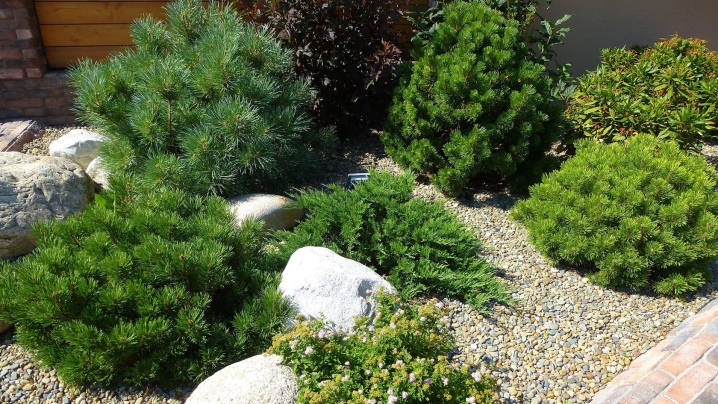
If there is a need to plant pine trees on the lawn, then it is better to abandon single bushes, which will simply merge with the lawn greens, and give preference to group plantings.
To create a cozy and comfortable seating area it is not necessary to purchase expensive plants that are difficult to care for and require increased attention. Designers recommend paying attention to easy-care and unpretentious spruce. If you are tired of standard trees, then it is worth planting shrubby spruces - they can be used to create various green compositions that can decorate any territory.
It is to this group of conifers that the mountain pine Pomilio belongs. A beautiful plant will not only decorate the site, but also help cleanse the air near the house, which will undoubtedly have a positive effect on the health of the owners.
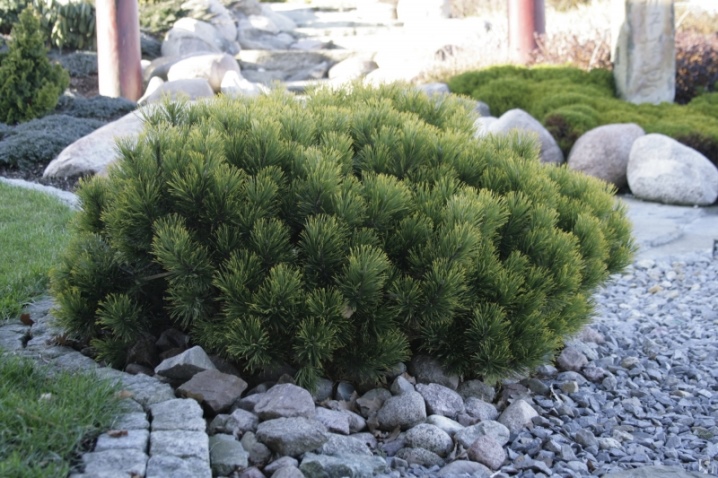
For information on how to properly care for the mountain pine Pumilio, see the next video.



































































The comment was sent successfully.